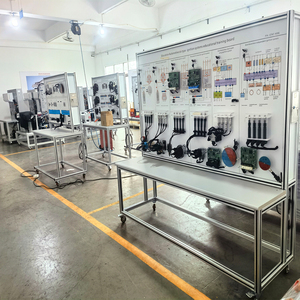Introduction to Mechatronics Simulators
The world of engineering is evolving rapidly, with mechatronics being a cornerstone of modern technology that merges mechanical, electronic, computer, and control engineering. A mechatronics simulator is an innovative tool designed to train, develop, and test mechatronic systems in a virtual environment. This cutting-edge technology allows engineers and students to learn and experiment with various mechatronic applications without the need for costly physical prototypes. The intricacies of mechatronic design can be complex, but a simulator simplifies the process by providing a platform for experimentation and exploration.
Types of Mechatronics Simulators
Mechatronics simulators come in various forms, tailored to different learning and operational requirements. The following types are prevalent in the industry:
- Software Simulators: These are computer-based programs that enable engineers to model, simulate, and analyze the dynamics of mechatronic systems.
- Hardware-in-the-Loop (HIL) Simulators: These systems integrate real hardware components with simulation software to validate control algorithms and system functionality in real-time.
- Desktop Simulators: Ideal for educational purposes, these simulators provide a user-friendly interface for students to explore mechatronic systems.
- Virtual Reality (VR) Simulators: Merging VR technology with mechatronics, these simulators allow an immersive experience for users, enhancing understanding and interaction with complex systems.
Applications of Mechatronics Simulators
Mechatronics simulators find their utility across various sectors, aiding in both academic environments and industrial applications. Here are some of the primary applications:
- Education and Training: Mechatronics simulators are essential in university curricula, allowing students to gain practical experience and understand theoretical concepts without extensive resources.
- System Design and Testing: Engineers utilize simulators to prototype designs and conduct performance evaluations before moving on to physical implementations.
- Robotics: In robotics development, simulators are crucial for programming, testing algorithms, and verifying system behaviors in a safe and repeatable environment.
- Automated Manufacturing: Simulators assist in creating and optimizing automated processes, enhancing efficiency and reducing errors during production.
Advantages of Using a Mechatronics Simulator
The integration of mechatronics simulators in engineering processes provides a plethora of advantages:
- Cost-Effective: By minimizing the need for physical prototypes, simulators significantly reduce development costs in the design and testing phases.
- Risk Reduction: Testing mechatronic designs in a virtual setting allows engineers to identify potential failures or issues before real-world implementation, minimizing risks.
- Enhanced Collaboration: Mechatronics simulators often include collaborative features that enable multiple team members to work on the same project simultaneously, improving teamwork and innovation.
- Rapid Prototyping: The speed of design iterations can be dramatically increased using simulators, facilitating faster product development timelines.














































